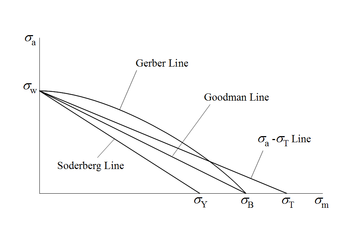Within the branch of materials science known as material failure theory, the Goodman relation (also called a Goodman diagram, a Goodman-Haigh diagram, a Haigh diagram or a Haigh-Soderberg diagram) is an equation used to quantify the interaction of mean and alternating stresses on the fatigue life of a material. The equation is typically presented as a linear curve of mean stress vs. alternating stress that provides the maximum number of alternating stress cycles a material will withstand before failing from fatigue.
A scatterplot of experimental data shown on an amplitude versus mean stress plot can often be approximated by a parabola known as the Gerber line, which can in turn be (conservatively) approximated by a straight line called the Goodman line.
Mathematical description

The relations can be represented mathematically as:
, Gerber Line (parabola)
- , Goodman Line
- , Soderberg Line
where is the stress amplitude, is the mean stress, is the fatigue limit for completely reversed loading, is the ultimate tensile strength of the material and is the factor of safety.
The Gerber parabola is indication of the region just beneath the failure points during experiment.
The Goodman line connects on the abscissa and on the ordinate. The Goodman line is much safer consideration than the Gerber parabola because it is completely inside the Gerber parabola and excludes some of area which is nearby to failure region.
The Soderberg Line connects on the abscissa and on the ordinate, which is more conservative consideration and much safer. is the yield strength of the material.
The general trend given by the Goodman relation is one of decreasing fatigue life with increasing mean stress for a given level of alternating stress. The relation can be plotted to determine the safe cyclic loading of a part; if the coordinate given by the mean stress and the alternating stress lies under the curve given by the relation, then the part will survive. If the coordinate is above the curve, then the part will fail for the given stress parameters.
References
- ^ Tapany Udomphol. "Fatigue of metals" Archived 2013-01-02 at the Wayback Machine. 2007.
- Herbert J. Sutherland and John F. Mandell. "Optimized Goodman diagram for the analysis of fiberglass composites used in wind turbine blades".
- David Roylance. "Fatigue". Archived 2011-06-29 at the Wayback Machine. 2001.
- "Fatigue" Figure 3.9
- Bhandari, V. B. (2007). Design of Machine Elements. Tata McGraw-Hill Education. pp. 184, 185. ISBN 9780070611412.
- Shigley's Mechanical Engineering Design. The Mc-Graw-Hill Companies. 2011. p. 305. ISBN 9780073529288.
- Hertzberg, pp. 530-31.
Bibliography
- Goodman, J., Mechanics Applied to Engineering, Longman, Green & Company, London, 1899.
- Hertzberg, Richard W., Deformation and Fracture Mechanics and Engineering Materials. John Wiley and Sons, Hoboken, NJ: 1996.
- Mars, W.V., Computed dependence of rubber's fatigue behavior on strain crystallization. Rubber Chemistry and Technology, 82(1), 51–61. 2009.
Further reading
- Mott, Robert L. (2004). Machine elements in mechanical design (4th ed.). Upper Saddle River, N.J.: Pearson Prentice Hall. pp. 190–192. ISBN 0130618853.
- Nisbett, Richard G. Budynas, J. Keith (2008). Shigley's mechanical engineering design (8th ed.). Boston : McGraw-Hill Higher Education. pp. 295–300. ISBN 9780073121932.
{{cite book}}: CS1 maint: multiple names: authors list (link)
 , Gerber Line (parabola)
, Gerber Line (parabola)
 , Goodman Line
, Goodman Line , Soderberg Line
, Soderberg Line is the stress amplitude,
is the stress amplitude,  is the mean stress,
is the mean stress,  is the
is the  is the
is the  is the
is the  on the abscissa and
on the abscissa and